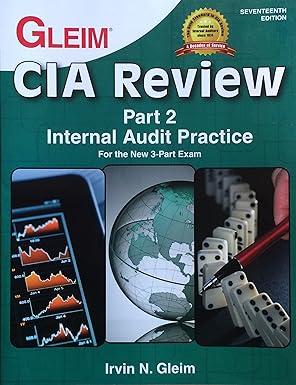Answered step by step
Verified Expert Solution
Question
1 Approved Answer
1) The company purchases inventory with a cost of $10,000 on account. The terms of the purchase are 2/10 n/30. 2) The company purchases supplies
1) The company purchases inventory with a cost of $10,000 on account. The terms of the purchase are 2/10 n/30.
2) The company purchases supplies of $5,000 with cash.
3) On January 1st of the year, the company gets a loan of $400,000 from a bank. The loan has an annual rate of interest of 5%. The annual payment on the loan is $75,000.
4) The company purchases a piece of machinery for $100,000. The machine is estimated to produce 40,000 units over its life. The company estimates the salvage value of the machine to be $5,000.
5) The company has sales to customers of $45,000 on account.
6) The inventory sold in transaction 5 is calculated to be worth $5,000.
7) The company estimates that 5% of the sales in transaction 5 won't be collectable.
8) The company pays the amount due on the inventory purchased in transaction 1. The company takes advantage of the reduced sales price for the 2/10 n/30 terms.
9) The company pays salaries to it's employees of $5,000.
10) The company collects $30,000 of cash from customers who paid on account.
11) The compnay collects $10,000 from a customer for an order that will not be completed until the next year.
12) The company writes off $1,000 of accounts receivable.
13) The company purchases inventory with a cost of $5,000 on account. The terms of the purchase are 2/10 n/30.
14) The company has sales to customers of $50,000 in cash.
15) The inventory sold in transaction 14 is calculated to be worth $5,500.
16) The company makes it annual payment of $75,000 on the loan to the bank.
17) The company collects $10,000 of outstanding accounts receivable.
18) On September 1 of the year, the company pays $12,000 for lease on an office. The lease term is one year.
19) The company pays general expenses of $4,500 in cash.
20) The company pays the amount due on the inventory purchases in transaction 13. The company takes advantage of the reduced sales price for the 2/10 n/30 terms.
adj At the end of the year, the company has supplies on hand of $500.
adj At the end of the year, the machine produced 8,000 units. The company uses the units of production method to calculate depreciation.
adj At the end of the year, the company accrues $10,000 of salaries due to employees.
adj At the end of the year, the company recognizes rent expense for the lease executed in transaction 18.
adj At the end of the year, a physical count finds $2,000 of inventory on hand.
Step by Step Solution
There are 3 Steps involved in it
Step: 1

Get Instant Access to Expert-Tailored Solutions
See step-by-step solutions with expert insights and AI powered tools for academic success
Step: 2

Step: 3

Ace Your Homework with AI
Get the answers you need in no time with our AI-driven, step-by-step assistance
Get Started


